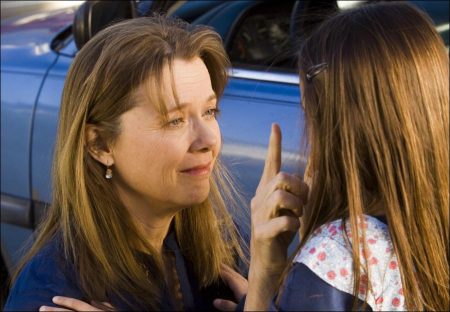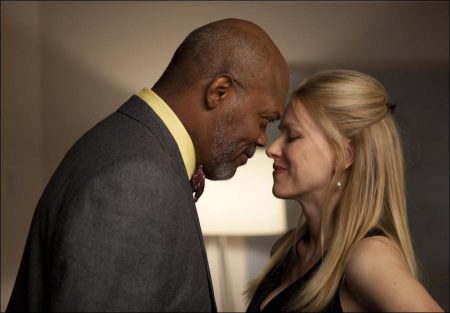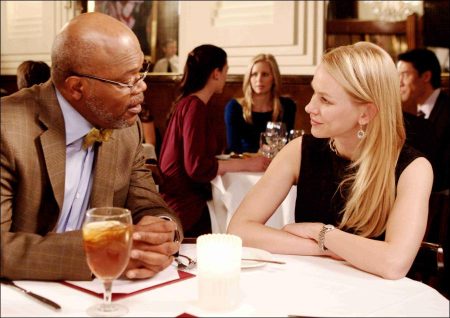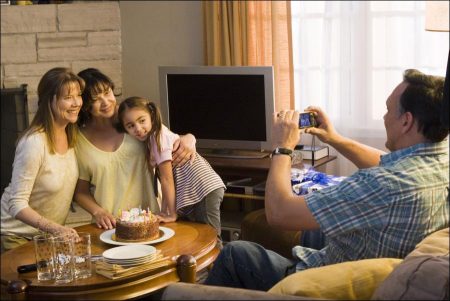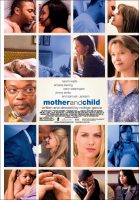Taglines: All roads of life lead to one.
Three women’s lives share a common core: they have all been profoundly affected by adoption. Karen (Annette Bening) had a baby at 14, gave her up at birth, and has been haunted ever since by the daughter she never knew. Elizabeth (Naomi Watts) grew up as an adopted child; she’s a bright and ambitious lawyer, but a flinty loner in her personal life. Lucy (Kerry Washington) is just embarking with her husband on the adoption odyssey, looking for a baby to become their own.
Karen lives with her elderly mother Nora (Eileen Ryan), works as a physical therapist in a rehabilitation clinic, and relies on Sofia (Elpidia Carrillo) to look after Nora and their home while she is working. While Karen and Nora barely speak, Karen keeps up a silent monologue addressed to her absent daughter, writing journal entries and letters never to be sent. Nora’s caregiver Sofia brings her little daughter Cristi (Simone Lopez) to work with her, and they enjoy a warmer relationship with Nora than does Karen. Karen resents Sofia and is uncomfortable around little Cristi. In fact, she’s uncomfortable around just about everybody-she’s a prickly, demanding, and unsociable woman at home and at work, where she coldly and rudely rebuffs the friendly gestures of a new therapist, Paco (Jimmy Smits).
Elizabeth has been newly hired at a tony law firm presided over by Paul (Samuel L. Jackson). Elizabeth impresses Paul with her sharp legal skills and blunt straight-talking style-but also with her take-charge attitude towards seduction. Before long, the sexy associate is having an affair with her much-older, widowed boss. Paul is a big-hearted family man with an expansive view of life, while Elizabeth is emotionally chilly; she describes herself as remote from her adopted family, with no close attachments.
Their opposites-attract affair is curious enough to keep them both interested. Elizabeth, though, enjoys sex as sport-and roping in her neighbor Steven (Marc Blucas) is her latest casual conquest. Steven is married to the very-pregnant Tracy (Carla Gallo), and Elizabeth seems to take pleasure, cruelly and deliberately, in undermining the happy-family-to-be.
Lucy and her husband Joseph (David Ramsey), disappointed that they can’t conceive, turn to Sister Joanne (Cherry Jones) at a private Catholic adoption agency. There they meet Ray (Shareeka Epps), a young pregnant woman who is interviewing potential parents for her unborn child. Ray is no grateful, helpless teenager-she’s an articulate adult with tough questions and a demanding attitude, but Lucy’s forthright candor wins Ray over.
Lucy is excited that she has at least made the first cut, but family and friends on all sides feed uncertainty. Ray’s mother Leitita (Lisa Gay Hamilton) discourages her from giving up the baby. Joseph’s parents can’t hide their disappointment that their “prince won’t have a blood heir. Lucy’s mother Ada (S. Epatha Merkerson), who helps Lucy run her successful bakery, is supportive but worried. Eventually, Joseph gets cold feet and admits that he wants his own biological child, even if that means breaking up with Lucy, however reluctantly.
When Nora dies, Karen is distraught to hear from Sofia that Nora blamed herself for ruining Karen’s life by making her give up her baby 37 years earlier-just the words that Karen waited in vain to hear herself. Looking for solace, Karen tracks down the father of her baby, Tom (David Morse), now a long-married father who confesses that he has never forgotten her. They make love, but Tom can’t live up to Karen’s expectations.
Out of her despair, though, comes an impulse to reach out to her tolerant and generous co-worker Paco, who is protective and drawn to her wounded neediness. They marry, and happiness seems finally within Karen’s reach. Paco encourages Karen to try to find her long-lost daughter. Karen’s adoption decades earlier was handled by the same Catholic agency that has connected Lucy and Ray. There, Sister Joanne explains to Karen that the only way for she and her daughter to find each other would be for one of them to leave a letter inviting contact in the agency’s file. Karen assumes that since her daughter never left such a letter, she must not want to make contact.
But Elizabeth is that daughter-and she does indeed want to find her birth mother, because she discovers that she is pregnant. She has decided to keep the baby and wants the child to know her grandmother. She writes a letter to her birth mother and leaves it with the adoption agency. Elizabeth had her tubes tied at 17, but she has- against all odds-conceived anyway. She can’t know if the baby is her boss Paul’s, or her neighbor Steven’s, but she takes flight, disappearing from her upscale apartment, job and life. Paul tracks her down and offers to take care of her and the baby, but she denies that it’s his, releasing him from obligation. The baby girl who is born by emergency C-section is brown-skinned-hence Paul’s-but Elizabeth dies giving birth, leaving her baby orphaned.
Meanwhile, Lucy has decided to go ahead with adopting Ray’s baby on her own. Lucy is present and ecstatic at the birth, but Ray changes her mind about giving up the baby. Lucy is devastated. There’s another baby, though, who needs a home-Elizabeth’s.
A year goes by, and Elizabeth’s letter is finally found in a pile of paperwork clutter at the agency. When the agency contacts her, Karen discovers that the daughter she never knew is dead, but her daughter’s daughter lives in her own neighborhood, adopted by Lucy. Their first meeting is joyful. New mother Lucy, her adopted daughter Ella, and Ella’s grandmother Karen begin to forge a new family connection.
Q & A with Rodrigo Garcia (Writer / Director)
Q: You both wrote and directed this film. Which process do you enjoy more?
Writing is harder for me. More riddled with insecurity. Is this good enough, different enough, suspenseful enough, human enough, real enough? Do I even like it? Will good actors be interested? The many versions of the real monster, who cares? Of course when it’s going well, there’s nothing like it. It makes me feels refined and good. Most of the time it’s a slog that fuels self contempt.
Directing is more physically demanding. My problem then is not isolation, but the opposite, constant interaction. Overdosing on people. Having to pretend that you’re the director. But to see what you imagined in the loneliness of your desk late at night live and breathe in front of you is intoxicating.
Q: How did the film get off the ground? What was the process in getting the film made?
It was a many-pronged approach. (Or is that a many-prayer approach?) Alejandro González Iñárritu sent the script to Naomi Watts and encouraged her to do it while Julie Lynn began the search for funding, other cast members and a first rate crew. An initial offer to Annette Bening did not pan out because of other commitments and that was a big disappointment. We had flirtations with studios, but the threats of strikes compromised that.
We got Kerry Washington on board at this point, but then Naomi became pregnant and we decided to postpone and wait for her. (That we postponed because she was pregnant we all thought would bring us good luck, given the nature of the material). Waiting for her contributed to Annette becoming available again, and then Sam and Jimmy signed on. That was a great high, the cast that lined up. Cherry Jones! Finally, when we had everything in the world but financing, Lisa Maria Falcone and Tom Heller of Everest Entertainment stepped in and made it possible. WestEnd in London also was very supportive with foreign pre-sales.
Q: What was the most difficult scene to shoot?
I went into most of them scared and was at ease right after the first rehearsal. So all of them, then none. I suppose the scene with young Karen and young Tom filled me with apprehension more than others. Fourteen-year-olds making out. Really? I have to direct that? Their seriousness and professionalism saved my behind.
Q: What is your favorite scene in the film?
I’ve never worked on anything that has so many scenes that I’m happy with. Here are three:
— When Karen finds out what her mother really thought about her.
— When Paul offers the world to Elizabeth.– When Lucy introduces herself and her husband and their dreams to Sister Joanne at the adoption agency.
Q: Where did you shoot the film and how long was the shoot?
We shot in locations in and around Los Angeles for 29 days.
Q: Many of your films are centered on women, with men playing second fiddle. What is it about women that you find so fascinating?
Ever since I began to write, my women characters have been more complex than the men, but I don’t know why. Since my movies are not essentially about women but about subjects that interest me, the sex of the characters is not always that important to me. Like any filmmaker I use the strongest tools that I have, and female characters are it. Jason Isaacs said to me that I write about women because it frees me to write about emotional subjects more emotionally. I like women and feminine things. Anything from the gregarious nature of women to pregnancy to a woman’s face trying to pick out clothing or seeing a handsome man. How they love their loved ones and how they drive each other crazy. The ways they pursue the things they want. Of course I don’t really know what they’re thinking-but what fun to imagine it.
Mother and Child (2010)
Directed by: Rodrigo Garcia
Starring by: Naomi Watts, Annette Bening, Samuel L. Jackson, Kerry Washington, Jimmy Smits, David Ramsey, Cherry Jones, Carla Gallo, Simone Lopez, Elpidia Carrillo, Kay D’Arcy, Bradford Alex
Screenplay by: Rodrigo Garcia
Production Design by: Christopher Tandon
Cinematography by: Xavier Grobet
Film Editing by: Steven Weisberg
Costume Design by: Susie DeSanto
Set Decoration by: Lisa Fischer
Music by: Ed Shearmur
MPAA Rating: R for sexuality, brief nudity and language.
Studio: Sony Pictures Classics
Release Date: May 7, 2010

